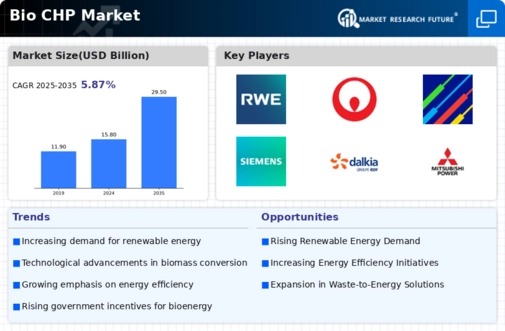Rising Demand for Renewable Energy
The increasing The Bio CHP Industry. As nations strive to meet ambitious climate targets, the demand for sustainable energy solutions has surged. In 2025, the renewable energy sector is projected to account for over 30% of total energy consumption, with bioenergy playing a crucial role. This shift towards cleaner energy sources is likely to enhance the adoption of bio combined heat and power systems, which utilize organic materials to generate electricity and heat. The Bio CHP Market stands to benefit significantly from this trend, as more businesses and municipalities seek to reduce their carbon footprints and transition to greener energy alternatives.
Government Regulations and Policies
Government regulations and policies aimed at reducing greenhouse gas emissions are pivotal in shaping the Bio CHP Market. Many countries have implemented stringent emissions targets, which necessitate the adoption of cleaner technologies. For instance, various jurisdictions have introduced feed-in tariffs and renewable energy certificates to incentivize the use of bioenergy. These regulatory frameworks not only promote the deployment of bio CHP systems but also create a favorable investment climate. As of 2025, it is estimated that policy-driven initiatives could lead to a 20% increase in the installation of bio CHP systems, thereby reinforcing the market's growth trajectory.
Economic Benefits of Bio CHP Systems
The economic advantages associated with bio CHP systems are a compelling driver for the Bio CHP Market. These systems not only provide dual energy outputs—electricity and heat—but also contribute to local economies by creating jobs in biomass supply chains and system maintenance. Furthermore, the potential for cost savings on energy bills makes bio CHP systems an attractive investment for businesses and institutions. In 2025, it is estimated that the economic impact of bio CHP installations could generate over 10 billion dollars in savings across various sectors, thereby reinforcing the market's appeal and encouraging further adoption.
Increased Awareness of Energy Security
The growing awareness of energy security concerns is driving interest in the Bio CHP Market. As energy prices fluctuate and geopolitical tensions rise, many regions are seeking to diversify their energy sources. Bio CHP systems offer a reliable and locally sourced energy solution, reducing dependence on imported fossil fuels. This trend is particularly evident in rural and remote areas, where bioenergy can provide a stable energy supply. By 2025, it is projected that the demand for bio CHP systems in these regions could increase by 25%, as communities prioritize energy independence and resilience.
Technological Innovations in Bioenergy
Technological advancements in bioenergy conversion processes are significantly influencing the Bio CHP Market. Innovations such as improved anaerobic digestion techniques and advanced gasification methods enhance the efficiency of biomass utilization. These technologies enable the conversion of a wider range of organic materials into energy, thus broadening the feedstock base for bio CHP systems. As efficiency rates improve, the economic viability of bio CHP installations increases, making them more attractive to investors. By 2025, it is anticipated that these technological innovations could lead to a 15% reduction in operational costs for bio CHP systems, further stimulating market growth.


















Leave a Comment